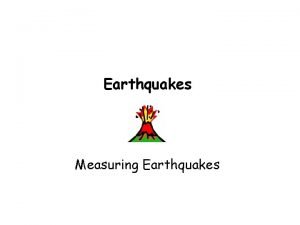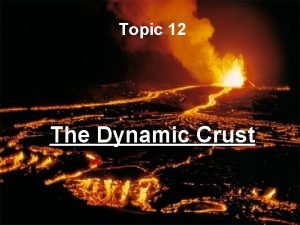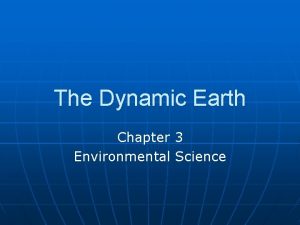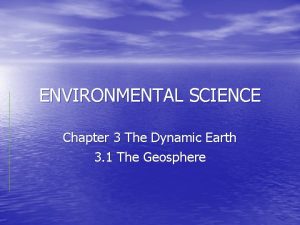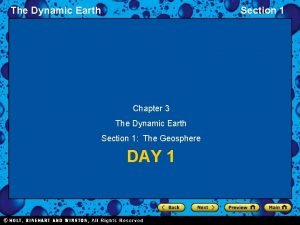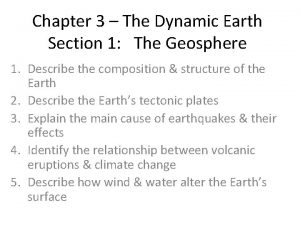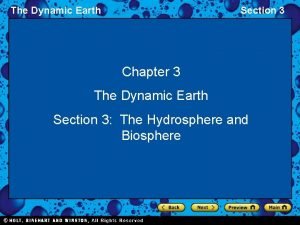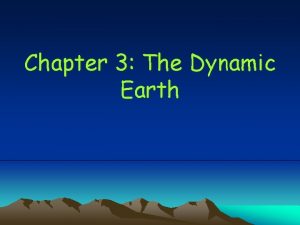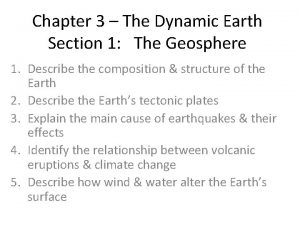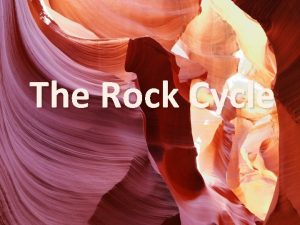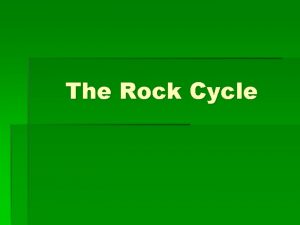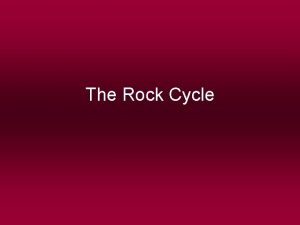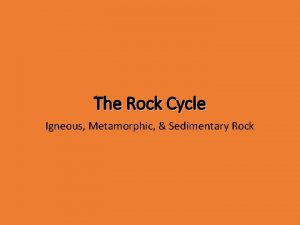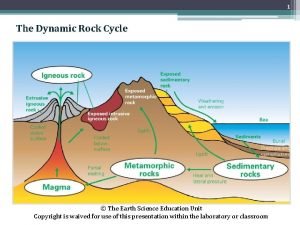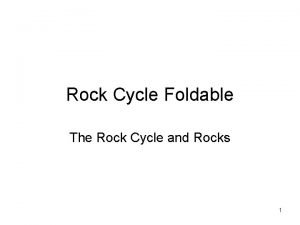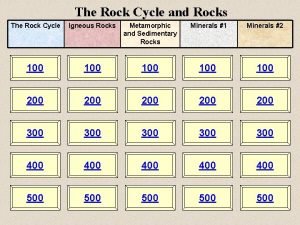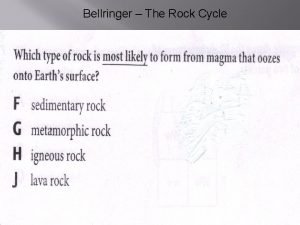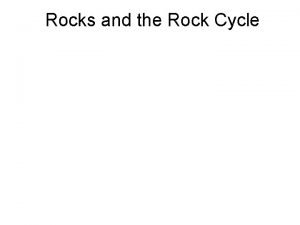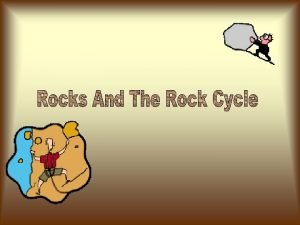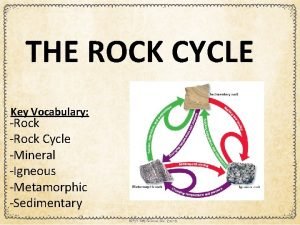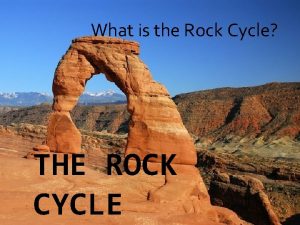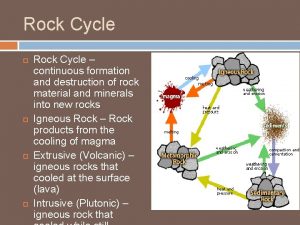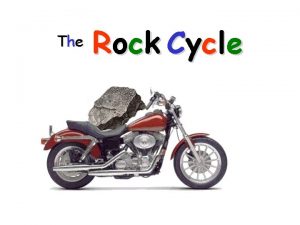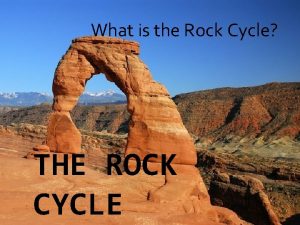The dynamic rock cycle Earth Science for KS
































































- Slides: 64

The dynamic rock cycle Earth Science for KS 3 science/geography Earth Science Education Unit www. earthscienceeducation. com © The Earth Science Education Unit Copyright is waived for original material contained herein if it is required for use within the laboratory or classroom. Copyright material included from other publishers rests with them. www. earthscienceeducation. com

• physical geography relating to: geological timescales and plate tectonics; rocks, weathering and soils; weather and climate, including the change in climate from the Ice Age to the present; and glaciation, hydrology and coasts KS 3 Statement www. earthscienceeducation. com

The dynamic rock cycle ‘Diagrammatic version of the rock cycle’

The dynamic rock cycle

The dynamic rock cycle Summary Try a series of ‘hands-on’ activities experimenting on and simulating the processes involved in the rock cycle. Use the integrating model of the rock cycle as a means of encountering common rocks and Earthprocesses in a practical, investigative way.

The dynamic rock cycle Workshop outcomes The workshop and its activities provide the following outcomes: • identification and terminology of rock cycle products, including soils, sediments and rocks; • knowledge and understanding about rock cycle processes and timescales, including weathering, erosion/transportation, deposition, compaction/cementation, metamorphism, melting, crystallisation, extrusion and deformation; • methods of teaching the abstract concept of the rock cycle, using a range of teaching approaches;

The dynamic rock cycle Workshop outcomes – continued • introduction to a range of Earth science laboratory activities, from simple modelling to more complex investigations; • approaches to activities designed to develop the thinking and investigational skills of pupils; • links between laboratory models and planetary processes, some of which are locally active and therefore relevant to pupils; • an integrated overview of the geological Earth science commonly taught to 11 – 14 year olds, based on the National Curriculum for Science (2007).

The dynamic rock cycle Starter Activity: Rock cycle products and processes Participants are asked to place a series of rock cycle products in the correct places on a diagram of the rock cycle, then to consider how all these are linked by rock cycle processes. They can use the ‘Rock reference sheet’ provided, if necessary.

The dynamic rock cycle ‘Diagrammatic version of the rock cycle’

The dynamic rock cycle • Place the rock cycle products (sediments, photographs and rocks) in the correct places on the Rock Cycle Diagram ‘The Rock Cycle’ • Use the rock reference sheet, if you need to

The dynamic rock cycle ‘The Rock Cycle’

The dynamic rock cycle Try out all these ‘rock cycle’ activities: • Laying out the rock cycle, starter Activity • Weathering – breaking up, or breaking down material at the Earth’s surface • 1 A Physical weathering - heating and cooling rock chips • 1 B Physical weathering - results of freeze/thaw weathering • 1 C Chemical weathering - action of carbonic acid on ground limestone • Erosion and transportation – investigating the resistance of rock samples to “erosion” • Deposition – investigating the movement of sand in water • Compaction and cementation of sediments • Metamorphism - detecting the distortion • Crystallisation - Salol • Extrusive igneous rocks • ‘Lava’ in the laboratory: the treacle investigation • A volcano in the laboratory: the wax volcano demonstration • Deformation – make your own folds and faults • ‘The rock cycle in wax’, plenary activities

The dynamic rock cycle Rock Cycle Feedback • • Name the topic you did Explain what you did: demo briefly How does this relate to the real world? Would you use it? If so, how is it best used with a class; group practical work; teacher demonstration; part of a circus etc? • Any safety implications?

Starter: ‘Teacher - What’s the difference between weathering and erosion? ’ Annotations by Chris King. Image in public domain

Starter: ‘Teacher - What’s the difference between weathering and erosion? ’ Pupil Statement Correct/incorrect + comment Possible practical activity in the classroom Ali Acid rain dissolves limestone in weathering Correct: the acid rain removes the limestone by dissolving it and carrying the solute away in solution – so this is weathering. Add vinegar, limescale remover or other acid to a cleanlybroken piece of limestone to show the reaction. In the reaction a soluble substance is produced which is then dissolved. Henry Rocks are worn away by weathering. Incorrect: rocks are worn away by erosion, by gravity, wind, water or ice although they may have previously been weakened by weathering. Putting rock samples into a plastic container and shaking – to demonstrate erosion Rosa Erosion is the transportation and deposition of sediment. Incorrect: erosion is the initial removal of sediment – which may then be transported and deposited; it can be the start of transportation. Adding water to a sand-filled gutter – after the sediment is eroded at the top, it is transported along the gutter and deposited in the pool at the bottom – through three distinct processes. Milly Flakes of bricks fall off in weathering. Incorrect: the removal of solid material is erosion, in this case, by gravity; the flakes may have been previously weakened by weathering though. Look for flakes of brick beneath old brick school walls – these, having been weakened by weathering, have been removed by erosion through gravity. Tom Wind blasting sand against a cliff works like sandpaper, eroding bits off. Correct: when solid material is removed by wind – this is erosion (even though it is being done by the weather in this case). Sand blasting can be demonstrated by a powerful electric fan directed at a pile of dry sand – but it can be very messy and anybody in the way should wear safety glasses.

Starter: ‘Teacher - What’s the difference between weathering and erosion? ’ Pupil Jenny Statement Weathering rounds off pebbles on the beach. Kevin Rocks under the frozen ice sheets in Antarctica are weathered by freezing and thawing. Correct/incorrect + comment Incorrect: beach pebbles are rounded by erosion, not weathering – the pebbles are thrown against one another in storms, abrading one another – a process called attrition. Incorrect: the physical break up of rock by ice requires many cycles of freezing and thawing; rocks beneath the Antarctic ice sheets remain frozen. Possible practical activity in the classroom Putting rock samples into a plastic container and shaking – to demonstrate erosion. Put a similar selection of fragments of different rocks (including some permeable ones) into two different plastic boxes (e. g. lunch boxes) and add enough water to cover the fragments. Leave on the table as a control. Put the other into a freezer or the freezing compartment of a fridge until it is frozen and then take it out and allow it to thaw. Examine it after this first cycle (not much will have happened). Repeat this for several cycles until the permeable rocks break up through the 9% expansion of water as it becomes ice. Then the contrast with the control is clear.

The dynamic rock cycle Activity 1: Weathering - breaking up or breaking down material at the Earth’s surface (tens to hundreds of years) Investigate three different types of weathering. Be ready to tell the rest of the group about the activities and your results.

The dynamic rock cycle Weathering – breaking up, or breaking down material at the Earth’s surface Gypsum, weathered by solution in rain water

The dynamic rock cycle Weathering – breaking up, or breaking down material at the Earth’s surface Limestone pavement with clints and grykes – carbonation-solution

The dynamic rock cycle Weathering – breaking up, or breaking down material at the Earth’s surface Chemical action causes “spalling”

The dynamic rock cycle Weathering and erosion Weathering definition: Weathering is the natural break up (physical break up) and break down (chemical breakdown) of rock and other materials in situ (in place) at the Earth's surface, without the removal of solid material Erosion definition: Erosion is the removal of solid material, which has usually been loosened by weathering - by gravity, flowing water, wind or ice; erosion is usually the beginning of transportation So, in summary: Weathering loosens solid material and removes dissolved material. If solid material is removed – this is erosion

The dynamic rock cycle Activity 2: Erosion and transportation - rock resistance (seconds to tens of years) Investigate rock resistance to find out how rocks erode at different rates and use this to explain the formation of uplands and coastal headlands by the more resistant rock types.

The dynamic rock cycle Erosion and transport – investigating the resistance of rock samples to “erosion” What will it look like in 10, 000 years ? Key From: ESTA, Science of the Earth 11 - 14, Sediment on the move. Sheffield: Geo Supplies

The dynamic rock cycle Erosion and transport – investigating the resistance of rock samples to “erosion” • Which rocks form headlands, hills? Which form bays, valleys? • What does it mean when you walk uphill? Key a) Geological map b) Geological cross section

The dynamic rock cycle Erosion and transport – investigating the resistance of rock samples to “erosion” A sandstone bump creates a blind summit

The dynamic rock cycle Activity 3: Deposition - the movement of sand in flowing water (seconds to thousands of years) Investigate the processes by which sediment grains are eroded, transported and deposited by flowing water, in the lab. ‘Rainstorm erosion’ (runoff from a heavy rain carries topsoil from unprotected, highly erodible soils in northwest Iowa)

The dynamic rock cycle Deposition – investigating the movement of sand in water The bed of a shallow stream. Which way is the current flowing?

The dynamic rock cycle Deposition – investigating the movement of sand in water Sand flats at Conway. Which picture matches the gutter – this one, or. . . ?

The dynamic rock cycle Deposition – investigating the movement of sand in water … this one?

The dynamic rock cycle Deposition – investigating the movement of sand in water Cross-bedded sandstones in the Orkneys

Circus activity : Flowing water – moving sand (Alternative equipment) The 2 litire platstic bottle in action (Peter Kennett)

Circus activity : Ice – grinding, gouging and depositing Britice animation Dynamic cycles, ice streams and their impact on the extent, chronology and deglaciation of the British–Irish ice sheet A Hubbard, T Bradwell, N Golledge, A Hall, H Patton, D Sugden & Stoker, M. 2009. Quaternary Science Reviews 28 (7), 758 -776

The dynamic rock cycle Activity 4: Compaction and cementation - sediments into rocks (hundreds to millions of years) All sediment was once loose. To become rock, the grains need to be squeezed together (compacted) and/or glued together (cemented). The amount of the compaction and the strength of the cementation affect the properties of sedimentary rocks. ‘Syringe on the palm of your hand press the plunger to squeeze water out’

The dynamic rock cycle Activity 5: Metamorphism - detecting the distortion (millions of years – during mountain building) These activities simulate the effects of pressure in forming metamorphic rocks. ‘Distortion’

The dynamic rock cycle Metamorphism - detecting the distortion A trilobite - as it lived (and died) • • A trilobite as found in the metamorphic slates of North Wales By how much has the trilobite been distorted? - 1/2, 1/3, 1/4, 1/5? By how much have the surrounding rocks been distorted? By how much has North Wales been distorted? What might be big enough to cause this scale of distortion? From: ESTA, Science of the Earth 11 - 14, Hidden changes in the Earth. Sheffield: Geo Supplies

The dynamic rock cycle Metamorphism - detecting the distortion Study each of the drawings below. They show several trilobites found in slates. The top left is an undistorted trilobite; the trilobites in the other pictures have been distorted by forces in the Earth.

The dynamic rock cycle Activity 6: Crystallisation - fast or slow cooling, large or small crystals (Extrusive – seconds to weeks; Intrusive - thousands to millions of years) We can find out why the crystals in igneous rocks have different sizes through simulating the growth of crystals from magma by growing crystals from a melt in the laboratory. microscope slides on the ‘freezer’ and ‘room temperature’ parts of the paper

The dynamic rock cycle Crystallisation (and melting) - Salol cooled slowly on a warm slide (video)

The dynamic rock cycle Crystallisation (and melting) - Salol cooled quickly on a cold slide (video)

The dynamic rock cycle Activity 7: Extrusion - Igneous rocks ‘in the laboratory’ (seconds to weeks) This Activity helps to investigate what controls the viscosity of lava and how this influences the shape of volcanic landforms. Mount Etna eruption

The dynamic rock cycle ‘Lava’ in the laboratory: the treacle investigation • Which volcano was formed by runny lava? • Which volcano was formed by slow-flowing lava? • Which sort of eruption would you like to watch? From: ESTA, Science of the Earth 11 - 14, Magma - introducing igneous processes. Sheffield: Geo Supplies

The dynamic rock cycle ‘Lava’ in the laboratory: the treacle investigation Scientific accuracy • Whilst the treacle model of magma correctly shows that the temperature of the magma, the amount of crystals it contains and its water/gas content (as well as its composition), all play key roles in how explosive eruptions are … • … water content has the opposite effect of that shown by the treacle model • For complex reasons, the more water a volcanic magma contains, the more explosive it usually becomes.

The dynamic rock cycle Activity 8: Deformation - make your own folds and faults (seconds [faulting] to millions of years [folding, faulting, metamorphism during mountain building]) This Activity shows how folded and faulted rocks can provide evidence of the size and direction of the forces which produced the deformation. ‘Folded strata’

The dynamic rock cycle Deformation – make your own folds and faults The Himalayas in 10 s…

The dynamic rock cycle Deformation – make your own folds and faults The Himalayas in 10 s!

The dynamic rock cycle Deformation – make your own folds and faults Squeezebox

The dynamic rock cycle Deformation – make your own folds and faults Break thrust, Lizard

The dynamic rock cycle Deformation – make your own folds and faults Normal fault, Orgreave opencast site

Circus activity 7: The washing line of time. (Peter Kennett)

Circus activity 7: The washing line of time Event First humans (genus Homo) First grasses K-T boundary mass extinction First flowering plants First birds First mammals First dinosaurs The ‘Great Dying’ mass extinction First reptiles First plants with seeds First amphibians First plants on land First animals with hard parts First multicellular organisms First eukaryotes First bacteria The origin of the Earth Millions of years ago (Ma) Distance from ‘present day’ (cm) 2 55 65 130 150 225 251 325 360 501 545 1200 2000 3500 4567 0. 2 5. 5 6. 5 13 15 22 22. 5 25. 1 32. 5 36 36 51 54. 5 120 200 350 460

Circus activity 8: How long does it take? – quick to very, very slow How long for lava to crystallise and become solid? © public domain How long for a new ocean to become 1000 km wide? ©public domain

Circus activity 8: How long does it take? – quick to very, very slow Very quick From seconds to minutes From minutes to weeks From weeks to years From years to thousands of years From thousands of years to millions of years From millions of years to thousands of millions (billions) of years Very, very slow How long: for an earthquake to happen? for a landslide to happen? for a pebble to be eroded from a river bed in a storm? for mud cracks to form and be preserved? for a flood deposit to be laid down? for lava to crystallise and become solid? for a glacial lake to fill with sediment? for a monument to erode away for an intrusive igneous rock to crystallise? do ice ages last? does the Earth's magnetism stay in the same direction without reversal (the N magnetic pole staying near the N geographical pole)? for a supercontinent to break up and reform a new ocean to become 1000 km wide for oceanic lithosphere to be recycled from spreading centre to subduction and up again?

Circus activity 9: The toilet roll of time Geological time (years ago) Event 0 years Today – the future begins here Oldest stone tools 2, 600, 000 years India/Eurasia collision – Himalayan Mountains formed 50, 000 years K-T mass extinction – dinosaurs became extinct 65, 000 years Early flowering plants 130, 000 years Beginning of the opening of the Atlantic Ocean 190, 000 years Early birds and mammals 220, 000 years The ‘great dying’ mass extinction 251, 000 years Supercontinent of Pangaea assembled 300, 000 years Early reptiles 325, 000 years 400, 000 years Early insects Early land plants 510, 000 years Early fish 530, 000 years ‘Cambrian explosion – life with shells and other hard parts 545, 000 years 1, 200, 000 years Early multicelled organisms Early organisms (eukaryotes) The toilet roll of time. (Chris King) with cells containing nuclei 2, 000, 000 years Build-up of free oxygen in atmosphere 2, 700, 000 years Early bacteria and algae 3, 500, 000 years Oldest known Earth rocks 4, 000, 000 years Origin of the Earth – geological time begins here 4, 567, 000 years

Circus activity 9: The toilet roll of time To emphasis the point that most of the ‘action’ on Earth happened relatively recently, show the pupils the ‘Evolution of life in 60 seconds’ video at: https: //www. youtube. com/watch? v=YXSEyttbl. MI

The dynamic rock cycle Plenary activity I: The rock cycle in wax When you have taught about the rock cycle, revisit and revise it with your pupils using a candle

The dynamic rock cycle Plenary activity II: A wax volcano in the lab Volcanoes are exciting – hence all the volcano footage on TV. They can be used to fire pupils’ imaginations, and safe analogues of the behaviour of molten rocks can be demonstrated in the school laboratory. This Activity consists of a teacher-led demonstration for the whole class. It also demonstrates how “rocks” may form below “ground”, as well as on the surface. ‘wax volcano’

The dynamic rock cycle Plenary activity II: A volcano in the lab (Click to set the volcano off)

The dynamic rock cycle Copyright ‘Diagrammatic version of the rock cycle’ © redrawn from an original by BP International Limited, with permission ‘The Rock Cycle’ © ESEU Background image: ‘Key Stage 3, Sc 3. 4 The environment, Earth and universe’ ©Peter Kennett Background image: ‘Attainment target 1: How science works’ © Peter Kennett Background image: ‘Attainment target 3: Materials, their properties and the Earth’ © Peter Kennett Background image: ‘Level 5’ © Peter Kennett Background image: ‘Level 6’ © Peter Kennett Background image: ‘Level 8’ © ESEU Background image: ‘Exceptional performance’ © Peter Kennett Rock reference sheet © Michèle Bourne and Peter Kennett, ESEU ‘Gypsum, weathered by solution in rain water’ © Peter Kennett ‘Clints and grykes – carbonation-solution’ © Peter Kennett ‘Chemical action causes “spalling”’ © Peter Kennett Investigating the resistance of rock samples to “erosion” © Earth Science Teachers’ Association (ESTA) ‘A sandstone bump creates a blind summit’ © Peter Kennett ‘Rainstorm erosion’ (runoff from a heavy rain carries topsoil from unprotected, highly erodible soils in northwest Iowa) © Photo by Lynn Betts, USDA Natural Resources Conservation Service ‘The bed of a shallow stream’ © Peter Kennett Sand flats at Conway (2 images) © Peter Kennett

The dynamic rock cycle Copyright continued… ‘Cross-bedded sandstones in the Orkneys’ © Peter Kennett ‘Syringe on the palm of your hand press the plunger to squeeze water out’ © ESEU ‘Distortion’ © ESTA, redrawn by ESEU ‘Trilobites’ (drawing and image) © ESTA ‘Trilobites’ (drawings) © Chris King, redrawn by ESEU ‘Microscope slide on the ‘room temperature’ part of the paper’ © ESTA, redrawn by ESEU ‘Salol cooled slowly on a warm slide’ © Peter Kennett ‘Salol cooled slowly on a cold slide’ © Peter Kennett Mount Etna eruption © Fabricius Volcano X and Y © ESTA ‘Folded strata’ © Peter Kennett ‘The Himalayas in 10 s…’ © Peter Kennett ‘Squeezebox’ © Peter Kennett ‘Break thrust, Lizard’ © Peter Kennett ‘Orgreave opencast site, South Yorkshire’ © Peter Kennett, ESEU ‘Red candles’ © Ioyna ‘Cheese grater’ © Emj ‘Matches – Swan Vestas’ © Oxfordian Kissuth ‘Wax volcano’ © Peter Kennett

The dynamic rock cycle ‘Diagrammatic version of the rock cycle’

The dynamic rock cycle

The dynamic rock cycle Workshop outcomes The workshop and its activities provide the following outcomes: • identification and terminology of rock cycle products, including soils, sediments and rocks; • knowledge and understanding about rock cycle processes and timescales, including weathering, erosion/transportation, deposition, compaction/cementation, metamorphism, melting, crystallisation, extrusion and deformation; • methods of teaching the abstract concept of the rock cycle, using a range of teaching approaches;

The dynamic rock cycle Workshop outcomes • introduction to a range of Earth science laboratory activities, from simple modelling to more complex investigations; • approaches to activities designed to develop the thinking and investigational skills of pupils; • links between laboratory models and planetary processes, some of which are locally active and therefore relevant to pupils; • an integrated overview of the geological Earth science commonly taught to 11 – 14 year olds.

The dynamic rock cycle Earth Science for KS 3 science/geography Earth Science Education Unit www. earthscienceeducation. com © The Earth Science Education Unit Copyright is waived for original material contained herein if it is required for use within the laboratory or classroom. Copyright material included from other publishers rests with them. www. earthscienceeducation. com
 Types of igneous rock
Types of igneous rock Dynamic equilibrium earth science
Dynamic equilibrium earth science Kesler science rock cycle answer key
Kesler science rock cycle answer key My favourite subject is maths
My favourite subject is maths Rock cycle sedimentary
Rock cycle sedimentary Igneous metamorphic and sedimentary
Igneous metamorphic and sedimentary Adventure sports bungee jumping
Adventure sports bungee jumping A rock climber's shoe loosens a rock and her climbing buddy
A rock climber's shoe loosens a rock and her climbing buddy A rock climber's shoe loosens a rock and her climbing buddy
A rock climber's shoe loosens a rock and her climbing buddy Easy rock cycle
Easy rock cycle Transferered
Transferered The point beneath earth's surface where rock breaks
The point beneath earth's surface where rock breaks Topic 12 earth's dynamic crust and interior
Topic 12 earth's dynamic crust and interior Chapter 3 the dynamic earth
Chapter 3 the dynamic earth Chapter 3 the dynamic earth
Chapter 3 the dynamic earth Dynamic earth structure
Dynamic earth structure The dynamic earth chapter 3
The dynamic earth chapter 3 Chapter 3 the dynamic earth
Chapter 3 the dynamic earth Chapter 3 the dynamic earth section 1 the geosphere
Chapter 3 the dynamic earth section 1 the geosphere The dynamic earth chapter 3
The dynamic earth chapter 3 Fspos
Fspos Typiska drag för en novell
Typiska drag för en novell Nationell inriktning för artificiell intelligens
Nationell inriktning för artificiell intelligens Vad står k.r.å.k.a.n för
Vad står k.r.å.k.a.n för Varför kallas perioden 1918-1939 för mellankrigstiden?
Varför kallas perioden 1918-1939 för mellankrigstiden? En lathund för arbete med kontinuitetshantering
En lathund för arbete med kontinuitetshantering Adressändring ideell förening
Adressändring ideell förening Personlig tidbok för yrkesförare
Personlig tidbok för yrkesförare A gastrica
A gastrica Densitet vatten
Densitet vatten Datorkunskap för nybörjare
Datorkunskap för nybörjare Stig kerman
Stig kerman Debattinlägg mall
Debattinlägg mall Autokratiskt ledarskap
Autokratiskt ledarskap Nyckelkompetenser för livslångt lärande
Nyckelkompetenser för livslångt lärande Påbyggnader för flakfordon
Påbyggnader för flakfordon Tryck formel
Tryck formel Offentlig förvaltning
Offentlig förvaltning Jag har nigit för nymånens skära
Jag har nigit för nymånens skära Presentera för publik crossboss
Presentera för publik crossboss Jiddisch
Jiddisch Bat mitza
Bat mitza Klassificeringsstruktur för kommunala verksamheter
Klassificeringsstruktur för kommunala verksamheter Fimbrietratt
Fimbrietratt Bästa kameran för astrofoto
Bästa kameran för astrofoto Centrum för kunskap och säkerhet
Centrum för kunskap och säkerhet Byggprocessen steg för steg
Byggprocessen steg för steg Mat för unga idrottare
Mat för unga idrottare Verktyg för automatisering av utbetalningar
Verktyg för automatisering av utbetalningar Rutin för avvikelsehantering
Rutin för avvikelsehantering Smärtskolan kunskap för livet
Smärtskolan kunskap för livet Ministerstyre för och nackdelar
Ministerstyre för och nackdelar Tack för att ni har lyssnat
Tack för att ni har lyssnat Referatmarkeringar
Referatmarkeringar Redogör för vad psykologi är
Redogör för vad psykologi är Stål för stötfångarsystem
Stål för stötfångarsystem Atmosfr
Atmosfr Borra hål för knoppar
Borra hål för knoppar Orubbliga rättigheter
Orubbliga rättigheter R formel
R formel Tack för att ni har lyssnat
Tack för att ni har lyssnat Steg för steg rita
Steg för steg rita Verksamhetsanalys exempel
Verksamhetsanalys exempel Tobinskatten för och nackdelar
Tobinskatten för och nackdelar Toppslätskivling dos
Toppslätskivling dos











